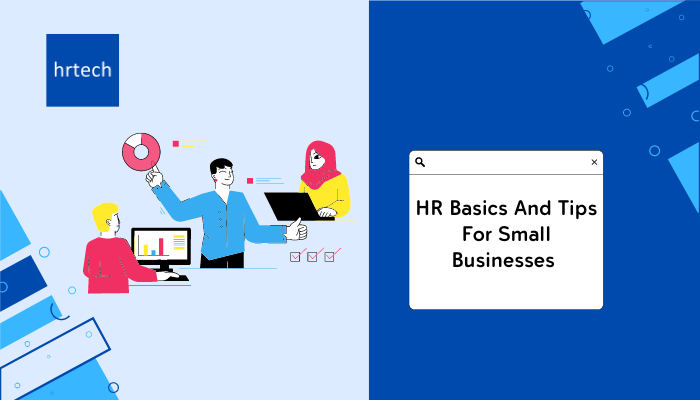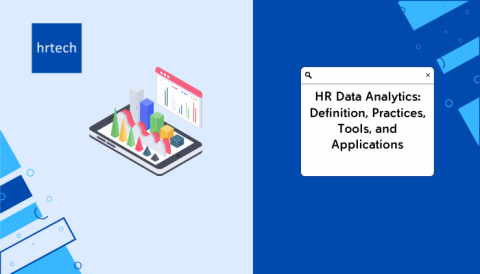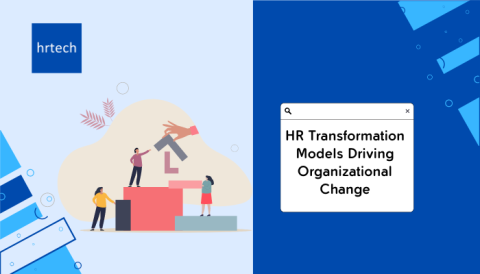Managing HR can be challenging for small businesses, especially when one has so many things to run independently.
In this guide, we’ll walk you through all the HR basics and 11 crucial HR tips that every small business owner should know.
Keep reading till the end to avoid common pitfalls and set your company up for success.
Transforming HR through Agile Workforce Solutions
HR Basics For Small Businesses:
In small businesses, HR is crucial in attracting, hiring, managing, and retaining talented employees who can help the company grow and succeed.
Effective HR practices ensure that your business complies with labor laws, supports employee development, and aligns workforce capabilities with your goals.
Small businesses may struggle with high turnover, low productivity, and legal issues without a solid HR foundation.
Implementing HR best practices in your small business can have several noticeable benefits.
Advantages Of Implementing HR In Small Businesses
Ensures compliance with complex laws and regulations which reduces the risk of legal issues down the line.
Effective HR supports business growth by attracting and retaining top talent, leading to increased productivity and innovation.
HR streamlines day-to-day functions like payroll and benefits administration which in turn helps owners and managers focus more on the core businesses functions and strategies.
Role Of HR In Small Businesses
HR plays an important role in small businesses by managing key functions that support employee success and business growth. For instance, here are essential functions that an HR handles:
Ensuring that employees are paid accurately and on time, while also maintaining records for tax purposes.
Researching and selecting benefits plans that attract top talent while fitting the company’s budget.
Developing a structured hiring process to identify and evaluate candidates efficiently.
Creating policies that provide proper guidelines for employees and managers.
Do Small Businesses Have HR?
Many small businesses don’t have a dedicated HR department, especially when they’re just starting out.

A huge majority – 81% small businesses handle HR processes by themselves without any proper HR help in their team.
HR tasks in small businesses are often handled by the business owner, office manager, or another employee who wears multiple hats.
However, just because a small business doesn’t have a formal HR department doesn’t mean they don’t need HR. Every business, regardless of size, has to manage essential HR functions like hiring, payroll, benefits, and compliance.
Without proper HR management, small businesses risk facing costly legal issues, high turnover, and low employee morale.
So, when should you consider HR implementation for your small businesses?
Once a business reaches 10-15 employees, it becomes more challenging to manage HR tasks in the DIY way. At this point, it’s wise to designate a part-time or full-time HR role to ensure consistency and compliance.
If your small business is facing complex HR challenges like frequent labor law changes, employee disputes, or rapid growth, it may be time to bring in HR expertise. This can be done by hiring an in-house HR professional, outsourcing to an HR consultant, or using HR software.
Do you have ambitious growth plans for your small business? Then investing in HR is a good idea to attract and retain top talent, streamline operations, and support long-term success.
So, while not all small businesses have a dedicated HR department, every business needs to prioritize HR.
11 Practical Tips And HR Advice For Small Businesses:
#1. Set Clear Guidelines
Establish clear guidelines and policies for your employees from the start. This includes defining job roles, responsibilities, and expectations. Clear guidelines are crucial because they help employees understand their duties, leading to better efficiency and fewer confusions.
Without clear guidelines, you may face challenges such as inconsistent performance, miscommunication, and even legal issues. To implement this effectively, create a comprehensive employee handbook that outlines all policies, procedures, and expectations.
For example, a small business with 20 employees should have a handbook that is at least 20-30 pages long and covers all essential topics like company policies, work hours, leave policies, and more.
#2. Form A Good Interview Process
A well-structured interview process is essential for identifying and hiring the best candidates for your organization.
It helps you evaluate a candidate’s skills, experience, and cultural fit. Without a good interview process, you risk making bad hiring decisions that can lead to high turnover rates and decreased productivity.
To implement an effective interview process, define the key skills and qualifications required for each role.
Create a standardized set of interview questions that assess these criteria.
Include a mix of behavioral and situational questions to gauge how candidates have handled real-world scenarios.
Did you know? On an average, it takes at least 3 rounds of interviews to find the best employee (as per 51% recruiters).
#3. Consider HR Compliance And Audits
Conducting regular HR audits is critical for ensuring compliance with labor laws and regulations. These audits help identify potential issues before they escalate into legal problems.
Additionally, managing sensitive employee information securely is crucial for protecting your employees’ privacy.
To stay compliant, keep accurate records of all employment documents, such as contracts, performance reviews, and disciplinary actions.
Collaborate with legal experts to create custom employment documents that follow the local regulations.
For example, a company with 50 employees should conduct a full HR audit at least once a year, reviewing all policies, procedures, and documents. Use secure digital storage systems and software solutions to manage employee records and maintain compliance.
#4. Create A Nice Work Environment

A positive work environment is essential for employee satisfaction, productivity, and retention. Use performance reviews to support employee development.
Regular feedback helps employees understand their strengths and areas for improvement, leading to better performance and growth. As we discussed earlier, a clear and accessible employee handbook is also crucial for creating a positive work environment.
It ensures all employees know the company’s policies, benefits, and expectations, reducing confusion and disputes. Build a strong company culture through employee engagement and recognition. Celebrate milestones, recognize achievements, and provide opportunities for team bonding.
For example, a company with 25 employees can organize monthly team-building activities and recognize an “employee of the month” based on team nominations.
#5. Ensure Proper Payments And Rewards
Paying employees accurately and on time is one of the most important responsibilities of any business. This includes regular wages, bonuses, and other compensation or benefits the employment contract promises.
Proper payment demonstrates that the company values its employees and helps maintain their trust and loyalty. Failing to ensure proper payments can lead to decreased employee morale, high turnover rates, and even legal issues. To avoid these challenges, use a reliable payroll system and keep accurate records of all payments and deductions.
#6. Make Your Onboarding Process Easy
A smooth and efficient onboarding process is essential for setting new hires up for success. It increases the chances of those employees staying with the company – by up to 82%.
A well-designed onboarding process helps new employees feel welcome and prepares them to contribute to the company’s goals. This includes completing necessary paperwork, providing training, and introducing them to the team.
Improperly structured onboarding processes can result in new hire confusion, decreased productivity, and higher turnover rates. To streamline your onboarding, create a checklist of all tasks and assign responsibilities to specific team members.
Designate one person to handle new hire paperwork and another to provide job-specific training. For instance, a company hiring 10 new employees should plan a 2-week onboarding program that includes a mix of HR paperwork, company culture training, and job-specific skills development.
Regularly gather feedback from new hires to identify areas for improvement in your onboarding process.
#7. Craft The Right Job Description To Attract The Right Talent

Clear and accurate job descriptions are crucial for attracting qualified candidates. A well-written job description outlines the essential duties, qualifications, and skills required for each role.
With the right job description, you increase the likelihood of finding candidates who are a good fit for your company and the specific position. Improper job descriptions can lead to receiving unqualified applicants, wasting time on irrelevant candidates, and ultimately making bad hiring decisions.
Did you know that a bad hiring decision can cost companies almost one-third of the 1st year earnings of the employee? So it’s crucial to make better hiring decisions. And for that, job descriptions are the best place to get started.
For example, instead of simply stating “good communication skills,” in the job description specify “ability to deliver clear and well organized presentations to 20+ team members.”
Aim for a short job description focusing only on the most essential information to set clear expectations.
#8. Design Your Company Culture
Company culture is the personality of your business. It includes the values, beliefs, and behaviors that shape how your employees interact and work together. A strong company culture attracts like-minded employees, improves job satisfaction, and sets you apart from competitors.
If you don’t intentionally design your culture, you may end up with a mismatched team and inconsistent work environment. This can lead to high turnover and low productivity. To create a positive culture, start by defining your core values and goals. Then, make sure these values are reflected in your policies, practices, and interactions.
For example, if one of your values is “work-life balance,” offer flexible schedules or remote work options. Regularly gather employee feedback and ideas to shape your culture.
#9. Retain Top Performers
Retaining your best employees is crucial for the long-term success of your business.
High-performing employees contribute more to your company’s goals, boost morale, and help attract other top talent.
Losing these employees can be costly, both in terms of productivity and replacement expenses.
To retain top performers, focus on providing growth opportunities, competitive compensation, and a positive work environment. Regularly recognize and reward their contributions.
Even statistics show that when you recognize employees for their work, there’s a 63% higher chance that they will stay with your company.
#10. Consider Performance Management
Performance management is the process of setting goals, providing feedback, and evaluating employee performance.
Effective performance management helps employees understand what is expected of them, identifies areas for improvement, and recognizes their achievements.
Without a structured performance management process, employees may lack direction and motivation. This can lead to subpar work and high turnover.
To implement performance management, start by setting clear, measurable goals for each role. Conduct regular check-ins and provide specific, actionable feedback.
#11. Make Overall HR Processes Effective Using Software Solutions
HR processes, such as hiring, onboarding, and benefits administration, can be time-consuming and complex.
Streamlining these processes makes your HR department more efficient and frees up time for strategic initiatives.
It also improves the employee experience by reducing confusion and frustration.
HR software solutions automate many administrative tasks, such as tracking employee information, managing payroll, and administering benefits.
|
HR Tasks: |
Software Solutions: |
|
Applicant Tracking |
Greenhouse, Workable |
|
Onboarding |
SAP SuccessFactors, BambooHR |
|
Payroll |
Gusto, Paychex |
|
Benefits Admin |
Zenefits, Rippling |
|
Performance Reviews |
Lattice, PerformYard |
Examples of HR tools and softwares suitable for small businesses include:
BambooHR: A comprehensive HR platform for managing employee data, time-off requests, and performance reviews.
Gusto: A payroll and benefits administration tool that streamlines tax compliance and offers employee self-service options.
Zenefits: An all-in-one HR solution that includes hiring, onboarding, and employee engagement features.
Rippling: A platform that integrates HR, IT, and finance functions, making it easy to manage employee data across systems.
Note: For small businesses, cloud-based HR software is often the most cost-effective and scalable option. All the above software examples are cloud-based HR softwares.
Check out our marketplace to explore a wide variety of HR tech software solutions suitable for different needs.
Conclusion
So, here’s a quick recap of the HR advice for small businesses we covered in this guide.
Start by understanding the basic functions of HR and how they apply to your business.
Focus on creating job descriptions, developing an employee handbook, and setting up payroll and benefits.
Then, as your business grows, consider hiring a dedicated HR professional or outsourcing HR tasks to a specialist HR firm.
Finding the right HR solution for your small business can be a bit challenging. But don’t worry because, at hrtech, our team of expert HR advisors is here to help you succeed by designing the right HR strategies for your business.





